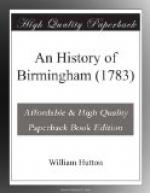These great roads were begun as soon as the island was subdued, to employ the military, and awe the natives, and were divided into stages, at the end of each was a fort, or station, to accommodate the guard, for the reception of stores, the conveniency of marching parties, and to prevent the soldiers from mixing with the Britons.
The stations upon the Ikenield-street, in our neighbourhood, are Little Chester (Derventione) a square fort, nearly half an acre; joining the road to the south, and the Derwent to the west.
The next is Burton upon Trent (Ad Trivonam) thirteen miles south. Here I find no remains of a station.
Then Wall (Etocetum) near Lichfield, which I have examined with great labour, or rather with great pleasure: Here the two famous consular roads cross each other. We should expect a fort in the angle, commanding both, which is not the case. The Watling-street is lost for about half a mile, leading over a morass, only the line is faintly preserved, by a blind path over the inclosures: the Ikenield-street crosses it in this morass, not the least traces of which remain. But, by a strict attention, I could point out their junction to a few yards.
Six furlongs west of this junction, and one hundred yards north of the Watling-street, in a close, now about three acres, are the remains of the Roman fortress. This building, of strength and terror, is reduced to one piece of thick wall, visibly of Roman workmanship, from whence the place derives its modern name.
Can you, says I to a senior peasant, for I love to appeal to old age, tell the origin of that building?
“No; but we suppose it has been a church. The ruins were much larger in my memory; but they were lately destroyed, to bring the land into that improved state of cultivation in which you see it.”—And so you reduced a fortress in four years, which the Britons never could in four hundred. For a trifling profit, you eraze the work of the ancients, and prevent the wonder of the moderns.—Are you apprised of any old walls under the surface?
“Yes; the close is full of them: I have broke three ploughs in one day; no tool will stand against them. It has been more expensive to bring the land into its present condition, than the freehold is worth.” Why, you seem more willing to destroy than your tools; and more able than time. The works which were the admiration of ages, you bury under ground. What the traveller comes many miles to see, you assiduously hide.
What could be the meaning that the Romans erected their station on the declivity of this hill, when the summit, two hundred yards distant, is much more eligible; are there no foundations upon it? “None.”
The commandry is preferable: the Watling-street runs by it, and it is nearer the Ikenield-street. Pray, are you acquainted with another Roman road which crosses it? “No.”
Do you know any close about the village, where a narrow bed of gravel, which runs a considerable length, has impeded the plough?




